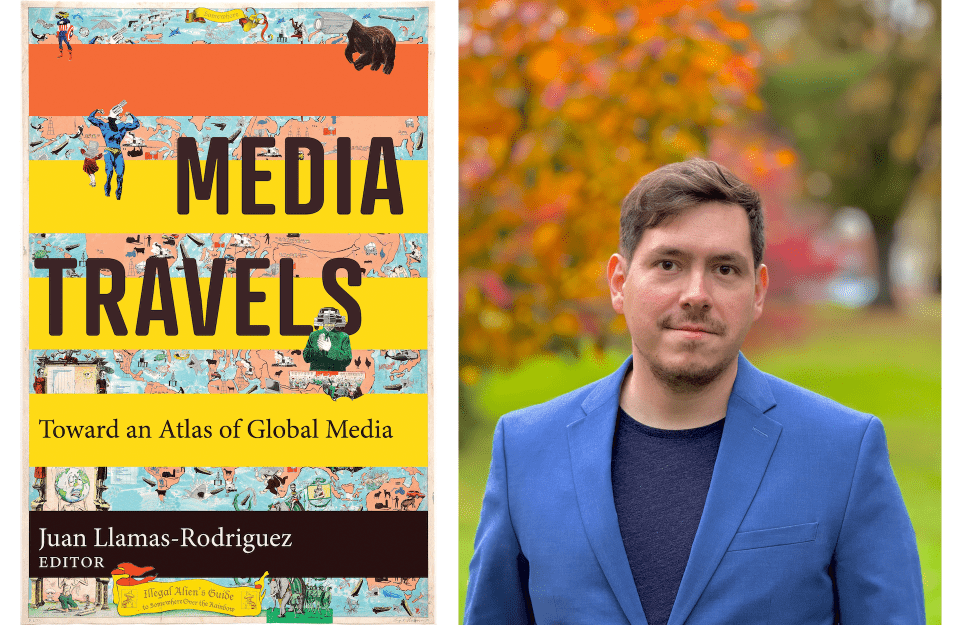Creating an Atlas of Global Media
A new edited collection from Annenberg Professor Juan Llamas-Rodriguez brings readers on a tour of media beyond the typical U.S. canon.

Reading Juan Llamas-Rodriguez’s new textbook on global media feels like embarking on a tour of the world’s complex communication landscapes. Each chapter opens a window into a different region, revealing how culture, politics, and history shape the way information is produced and consumed.
Four years ago, Llamas-Rodriguez, Assistant Professor of Communication at the Annenberg School for Communication at the University of Pennsylvania, met with a group of fellow media scholars to discuss a common challenge: how to expand the curriculum of their courses beyond the typical U.S.-Anglo-centric canon.
“We all wanted to make media from outside of the U.S. a core part of our teaching, but many of us didn’t feel prepared to teach media outside of our specific expertise or location,” he said. “One of the ideas we floated was, ‘What if there was a collection that helps scholars bring in perspectives from around the world into their classes?’”
What emerged is an edited collection by Llamas-Rodriguez, “Media Travels: Toward an Atlas of Global Media” (Amherst College Press, 2025), which includes eleven essays by scholars and experts on media across cultures — from viral Russian roofing videos to the popularity of Korean TV series in Latin America.
A Journey Through Multimedia
The book, which is open access and available in full online, is designed to be interactive, multimodal, and appealing to readers in and outside of the classroom. When Llamas-Rodriguez writes about the documentary Cameraperson (Kirsten Johnson, 2016) in the book’s introduction, noting the film’s textures and structure, readers don’t have to imagine the film’s contents; they can scroll to the right and watch a clip. When media studies scholar Benjamin M. Han discusses how the Korean TV drama Secret Garden takes on stylistic elements of a classic telenovela, readers can watch a scene from the show featuring the romantic leads.
Incorporating multimedia in the book is important to Llamas-Rodriguez. “Media scholars are used to a couple of screen grabs being the only things accompanying an essay on a piece of media, so throughout the process of putting together the book, I kept encouraging people to think about what media they could include in their chapters,” he said. He was especially excited about the inclusion of recordings of video game gameplay in the book, something he hasn’t often seen in academic literature. “Seeing someone play a game is so much richer than just seeing a screenshot of a game,” he said.
Beyond Borders
In putting together the book, Llamas-Rodriguez, Associate Director of the Center for Advanced Research in Global Communication (CARGC) at Annenberg, said he was inspired by the Center’s 2023 “Doing Global Media Studies” symposium, which was organized by the doctoral and postdoctoral fellows at the Center and brought global media scholars to Annenberg to share research that transcends borders.
“The symposium was really impressive. I was invited to be part of a workshop on teaching media studies, and a lot of the doctoral fellows came and talked about both the material issues and the broader conceptual, theoretical issues about what it means to teach global media studies, and that really inspired my thinking on the book,” said Llamas-Rodriguez.
Llamas-Rodriguez is particularly proud that the book has an appeal to readers outside of academia.
“Editorially, I tried to encourage each of the contributors to clarify key concepts in a way that people who are just generally interested in media in a certain part of the world would be intrigued and educated, and I think they did just that.”



